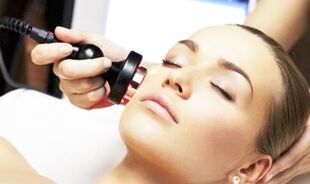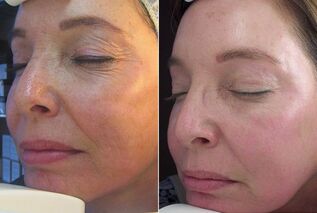For a long time, plastic surgery was the only way to regenerate. But this method has many contraindications, and is also associated with certain health risks, therefore, not all of them can be resolved with the help of surgical intervention. Fortunately, modern aesthetic medicine offers many less hazardous anti-aging treatments. One of the worthwhile alternatives to plastic surgery is a laser facelift.
What?
Laser liftingis a modern non-surgical way to combat age-related skin changes. This technique is aimed at improving the quality of the skin. It stimulates regenerative processes (cell renewal), improves blood circulation in the areas of laser exposure, which helps to track wrinkles.
During the procedure, natural collagen is actively produced, which provides tissue elasticity. This is especially important for areas with smooth skin, where different methods of rejuvenation are not acceptable.
The difference between laser lifting and other methods of plastic surgery and resurfacing is that this procedure does not involve surgery. The operation is performed using special equipment for laser therapy. The beam of light passes through the skin and acts on weak and dead cells.
Laser facelifts can be done for women and men between the ages of 18 and 70. This procedure is often necessary after 30 years, when the first signs of skin aging appear.
Cosmetologists usually prescribe laser lifting courses, as one session is not enough. The maximum effect can be achieved 3 months after the last procedure performed. With proper skin care, the rejuvenating effect can last about three years.
Indications for the procedure
Laser lifting will help solve a large number of problems. Patients with the following problems are prescribed the procedure:

- saggy skin of the eyelids; expressions
- and age wrinkles; dark circles and bags
- under the eyes;
- pronounced nasolabial fold; acne scars
- ; small scars
- ; Enlarged pores
- ;
- unhealthy complex;
- presence of age spots; vascular networks
- ;
- sagging double chin; neck wrinkles
- .
Contraindications
Laser surge is contraindicated in the presence of the following factors:
- inflammatory diseases and acute infections;
- any oncological diseases;
- chronic diseases;
- various blood diseases; pregnancy and lactation
- ; HIV infection
- ; diabetes
- diabetes mellitus; mental disorders
- ;
- diseases involving the thyroid gland; titimeas
- ; hepatitis
- ;
- skin diseases of any kind;
- poor blood clotting.
Types of skin resurfacing
Currently, in cosmetology practice, lasers are raised using two technologies: ablative and non-ablative. They are different in that they all use a different type of laser.
Ablative
Relative is the most prevalent laser lifting technology.The impact of the light beam is focused on the outer layer of the epidermis, which is constantly in contact with the environment.
Under laser action, the dead layers of skin are gradually evaporated. The abrupt change is traumatic, but it guarantees the result.
Non-ablative
This technique involves a laser beam penetrating deep into the skin, stimulating collagen and elastin synthesis. The top layer of skin remains intact. This method helps to raise a laser to improve tissue tone, resulting in regrowth.
Unlike abutment aggravation, also known as "burn", the non-ablative technique is considered quieter. The non-abrasive lifting method is allowed to be used to affect sensitive areas of skin - the eyelids and the area around the eyes.
This technology is not very popular, as many cosmetologists doubt its effectiveness.
Preparing for the procedure
Prior to the laser lifting procedure, it is necessary to visit a cosmetologist who will assess the general condition of the skin and conclude on the suitability of the operation.To reduce the risk of side effects, you will need to pass the following tests:
- general analysis of blood and urine; chest x-ray
- ; Syphilis test
- ; HIV testing
- ;
- cardiogram of the heart.
The doctor should also be aware of all the diseases suffered by the patient.
About two weeks before the session, there are simple rules to follow:
Refuses to- visit the bathroom, sauna and solarium, and also does not sunbathe in the sun; do not drink
- alcoholic beverages;
- drinks antiviral drugs in a course (as prescribed by one cosmetologist).
It is not advisable to consume coffee and energy drinks on the day of the session.
How is a replay done?
The technique for making a laser lift is relatively simple:

- The patient puts a medical cap or bandage over his head to remove his hair and lies down on the couch.
- Next, the doctor prepares the skin: removes remnants of make-up and greasy secretions.
- Cooling gel is then applied to the face. Anesthetic creams are used for patients with very sensitive skin.
- The procedure is painful. For this reason, it is often performed under local or general anesthesia.
- During the session, the patient's eyes must be protected, so that they wear dark glasses. After you have completed the preparatory measures, you can begin the laser lifting process.
- The doctor runs a special device with a handpiece (maniple) over the patient's face, paying particular attention to problem areas and working them out carefully.
Different equipment is used depending on the procedure used. It differs in the technology of exposure and depth of penetration of the light beam.
There are two types of lasers: cold and hot. For recirculation, carbon dioxide, erbium or diode lasers can be used.
- The carbon dioxide laser is the most powerful. Helps get rid of any wrinkles and scars.
- Erbium effectively fights the first signs of aging. It has a mild effect on the surface of the skin.
- Skin is deeply rejuvenated by a diode laser. The light beam can penetrate 5-50 mm inwards.
Carbon dioxide lasers are relatively refreshed. Under the influence of heat, dead cells gradually evaporate, eventually leaving new and young skin.
Erbium and diode lasers are used for non-ablative refraction.The action of the light beam is focused on the inner layers of the skin. Collagen production processes are stimulated in the connective tissues, which helps to tighten and rejuvenate the skin.
After the end of the procedure, the beauty treats the patient's face with an antiseptic, then applies a moisturizing cream or mask.
Before and after photos
Further on in the photo you can see the result before and after the procedure.

Recovery
The length of the recovery period depends on the technology of the procedure.The more severe the impact, the longer it will take for the skin to fully regenerate.
During rehabilitation, skin redness, swelling and hypersensitivity are common. These are permissible consequences of raising a laser and should not be frightening. After a few days, the symptoms will go away on their own.
After a laser lift, the skin needs gentle care. The patient must strictly follow the doctor's recommendations and adhere to the following rules:
- does not visit the pool, sauna, bathroom and beach for two or three months; be sure to use
- sunscreen when going outdoors; Do not use
- decorative cosmetics until the skin is completely regenerated;
- try to touch your face with your hands as little as possible;
- exclude facial massage; giving up bad habits
- ;
- follow a healthy diet;
- drinks plenty of fluids.
With proper care and adherence to the beautifier's instructions, the results of the exacerbation can already be seen after seven days. The skin will be firmer and healthier, wrinkles and scars will be gone. The human oval will assume a flat shape and clear outlines. Changes do not usually appear immediately after the procedure.
Complications
Laser regression is considered a safe method of rejuvenation. During the procedure, there is no direct skin contact with the equipment, so the risks of infection with various diseases are minimized. Difficulties can arise in two cases: the inadequate level of professionalism of the cosmetologist and the patient's non-compliance with the rules of care.
The most dangerous side effects are:
herpes- ;
- increase in skin pigment; white ones
- ; Scar formation
- (in case of tearing of the formed crust).
























































